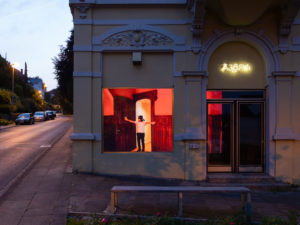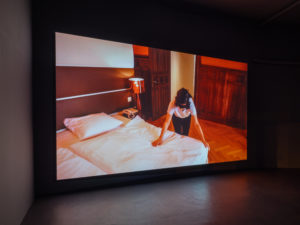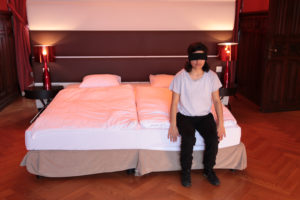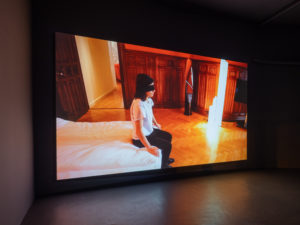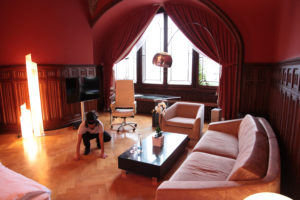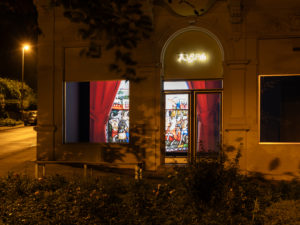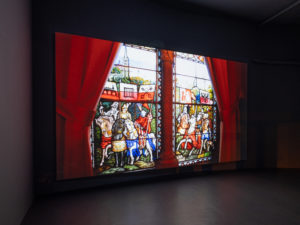16.23
Mîrkan Deniz 95th Anniversary of the Treaty of Lausanne at the Château d’Ouchy
95th Anniversary of the Treaty of Lausanne at the Château d’Ouchy
More
During the nearly ten-minute performance, the individual seems to immerse themselves in the interior, meticulously creating a three-dimensional mental image. Deniz pays close attention to almost every piece of furniture, as if engaging in an imaginary dialogue with each one.
The camera’s final shot lingers on a stained-glass window depicting a historical event. Throughout the performance, the artist is filmed exploring this space in a single, continuous, uninterrupted take. Not a single word is uttered; instead, the original sound becomes a presence in its own right. The act of touching and stroking different surfaces and textures is made audible, allowing the viewer to experience tactility with their ears as opposed to their fingers: the surface feel of the freshly made bedspread, ornamentation on the wooden wall paneling, the texture of the sofa’s woven upholstery.
As a viewer, one initially feels a sense of puzzlement. Several questions spring to mind: Why are they blindfolded? What is Deniz remembering in these quiet moments? What is the particular significance of this hotel room, and where is it located? What references or connections are deliberately not being made? Why the absence of spoken words throughout the performance? Why the lack of additional, contextual information about the Treaty of Lausanne? Where exactly is this castle located, and how does Switzerland figure into this on a political level?
After the First World War and the collapse of four global empires, Europe was plagued by violence and instability. The 1923 Treaty of Lausanne brought an end to World War I hostilities and established the borders of Turkey. But it also had profound consequences for minorities in Turkey who were unable to secure their rights. The treaty included, among other provisions, extensive (forced) resettlement as part of a process referred to as a “population exchange” between Greece and Turkey. Armenian and Kurdish populations were unable to realize their aspirations for autonomy and a separate state through the treaty. As a result, Kurdistan was divided geographically and politically into four states: Turkey, Syria, Iraq, and Iran.
Mîrkan Deniz puts a spotlight on the location of historical occurrences and examines the extent to which spaces, artifacts, and everyday objects – as (silent) witnesses to these events – also carry history(ies) within them. Their artistic investigation questions architectures and spaces through reconstruction and intervention to draw attention to past events, their historiography, and collective memory. The approach makes it possible to revisit political negotiations such as the Lausanne Peace Treaty, the effects of which are still being felt today, and opens a space for dialogue.
With this and other works, Deniz sets out on a quest for historical traces, which they then reconstruct or quote to create conceptual works in various media, including video, installation, and sculpture. Their fascination lies in the interplay between material and immaterial effects – trauma, unspoken experiences, and memories. How can an object, such as a sculpture, uphold this tension while simultaneously examining the relationship between the past, violence, and subjectivity? To illustrate this, they use, for example, replicas of objects with historical ties to or that represent specific events. In the case of Masa 2015/16, a replica of the table used for the signing of the Lausanne Peace Treaty was created. The original was presented to Turkey as a gift by Swiss President Pascal Roger Couchepin in 2008. In response, Deniz staged two different artistic actions: the first in 2015 in front of the Palais de Rumine in Lausanne, where the treaty was signed, and a year later, a repeat action in front of the Federal Palace in Bern. The “gift” continues to be rejected. The table is currently on view in the frontières exhibition at Musée Historique Lausanne.
Another recent installation, On the fringes, 2022, also draws inspiration from the events of 1923. An oriental carpet with extra-long fringes, intricately woven with the date “1923,” takes its place alongside various everyday objects. Recent years have seen demonstrators in Palestine, Kurdistan, and Lebanon lay similar carpets in the streets to mark their own areas of protest and sanctuary in the public sphere. The extended fringes of the carpet point symbolically to the fact that the protests and history are ongoing, never truly concluded. These works, along with the video piece on view, are a testament to the ways in which Deniz’s precise exploration of a historical event skillfully links past and present, and in doing so opens a varied, multi-vocal space for memory and dialogue.
Mîrkan Deniz (stateless, born in 1990) lives and works in Zurich. The artist was recently awarded the Young Academy prize of the Akademie der Künste Berlin (2017), a Swiss Art Award (2019), and the Art Award of the City of Zurich (2020). Recent solo exhibitions include frontières at Musée Historique Lausanne (2023) and the public art action and performance performing in a room with history, Lausanne (2023), and at Akademie der Künste Berlin (2017). Deniz’s work has also featured in various group exhibitions, including those at Aargauer Kunsthaus (2020/2021), Haus Konstruktiv, Zurich (2021), and Helmhaus Zurich (2020).
The camera’s final shot lingers on a stained-glass window depicting a historical event. Throughout the performance, the artist is filmed exploring this space in a single, continuous, uninterrupted take. Not a single word is uttered; instead, the original sound becomes a presence in its own right. The act of touching and stroking different surfaces and textures is made audible, allowing the viewer to experience tactility with their ears as opposed to their fingers: the surface feel of the freshly made bedspread, ornamentation on the wooden wall paneling, the texture of the sofa’s woven upholstery.
As a viewer, one initially feels a sense of puzzlement. Several questions spring to mind: Why are they blindfolded? What is Deniz remembering in these quiet moments? What is the particular significance of this hotel room, and where is it located? What references or connections are deliberately not being made? Why the absence of spoken words throughout the performance? Why the lack of additional, contextual information about the Treaty of Lausanne? Where exactly is this castle located, and how does Switzerland figure into this on a political level?
After the First World War and the collapse of four global empires, Europe was plagued by violence and instability. The 1923 Treaty of Lausanne brought an end to World War I hostilities and established the borders of Turkey. But it also had profound consequences for minorities in Turkey who were unable to secure their rights. The treaty included, among other provisions, extensive (forced) resettlement as part of a process referred to as a “population exchange” between Greece and Turkey. Armenian and Kurdish populations were unable to realize their aspirations for autonomy and a separate state through the treaty. As a result, Kurdistan was divided geographically and politically into four states: Turkey, Syria, Iraq, and Iran.
Mîrkan Deniz puts a spotlight on the location of historical occurrences and examines the extent to which spaces, artifacts, and everyday objects – as (silent) witnesses to these events – also carry history(ies) within them. Their artistic investigation questions architectures and spaces through reconstruction and intervention to draw attention to past events, their historiography, and collective memory. The approach makes it possible to revisit political negotiations such as the Lausanne Peace Treaty, the effects of which are still being felt today, and opens a space for dialogue.
With this and other works, Deniz sets out on a quest for historical traces, which they then reconstruct or quote to create conceptual works in various media, including video, installation, and sculpture. Their fascination lies in the interplay between material and immaterial effects – trauma, unspoken experiences, and memories. How can an object, such as a sculpture, uphold this tension while simultaneously examining the relationship between the past, violence, and subjectivity? To illustrate this, they use, for example, replicas of objects with historical ties to or that represent specific events. In the case of Masa 2015/16, a replica of the table used for the signing of the Lausanne Peace Treaty was created. The original was presented to Turkey as a gift by Swiss President Pascal Roger Couchepin in 2008. In response, Deniz staged two different artistic actions: the first in 2015 in front of the Palais de Rumine in Lausanne, where the treaty was signed, and a year later, a repeat action in front of the Federal Palace in Bern. The “gift” continues to be rejected. The table is currently on view in the frontières exhibition at Musée Historique Lausanne.
Another recent installation, On the fringes, 2022, also draws inspiration from the events of 1923. An oriental carpet with extra-long fringes, intricately woven with the date “1923,” takes its place alongside various everyday objects. Recent years have seen demonstrators in Palestine, Kurdistan, and Lebanon lay similar carpets in the streets to mark their own areas of protest and sanctuary in the public sphere. The extended fringes of the carpet point symbolically to the fact that the protests and history are ongoing, never truly concluded. These works, along with the video piece on view, are a testament to the ways in which Deniz’s precise exploration of a historical event skillfully links past and present, and in doing so opens a varied, multi-vocal space for memory and dialogue.
Mîrkan Deniz (stateless, born in 1990) lives and works in Zurich. The artist was recently awarded the Young Academy prize of the Akademie der Künste Berlin (2017), a Swiss Art Award (2019), and the Art Award of the City of Zurich (2020). Recent solo exhibitions include frontières at Musée Historique Lausanne (2023) and the public art action and performance performing in a room with history, Lausanne (2023), and at Akademie der Künste Berlin (2017). Deniz’s work has also featured in various group exhibitions, including those at Aargauer Kunsthaus (2020/2021), Haus Konstruktiv, Zurich (2021), and Helmhaus Zurich (2020).
Text Cynthia Krell
Translation Amy Patton
Mîrkan Deniz
95th Anniversary of the Treaty of Lausanne at the Château d’Ouchy, 2018
HD video, color with sound
10:00 min.
Courtesy of Mîrkan Deniz
Close
Translation Amy Patton
Mîrkan Deniz
95th Anniversary of the Treaty of Lausanne at the Château d’Ouchy, 2018
HD video, color with sound
10:00 min.
Courtesy of Mîrkan Deniz

